Discover chemistry-inspired travel destinations that will spark your curiosity and sense of adventure. Some of these places can be explored online, perfect for the travel-averse, the eco-conscious, or those running out of vacation days.
In this article, we present 16 exciting destinations outside of Europe for chemists to explore, complementing our previous guide to European sites. These are just a few options, and we’d love to hear about any chemistry-related sites we may have missed in this or our previous European travel article that you think are worth visiting.
Let’s start our exciting chemistry trip in South America:
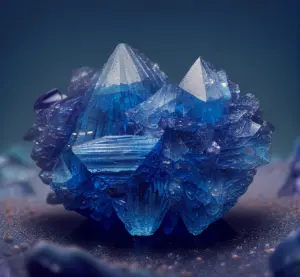
1 🏛️⚒️ Peru’s Amazing Geological Riches
Museo de Minerales Andres del Castillo, Lima, Peru
See the destination
Housed in the historic Casa Belén, a restored 17th-century villa, the museum opened in 2008. It features an extensive and exceptional collection of crystallized minerals from Peru, showcasing the nation’s mining wealth and the beauty and complexity of minerals.
Peru, known for its rich mineral resources, was according to Wikipedia, the world’s second-largest producer of copper, silver, and zinc in 2019; the third-largest producer of lead; the fourth-largest producer of tin and molybdenum; the fifth-largest producer of boron; and the eighth-largest producer of gold.
The Andrés del Castillo Foundation, led by Guido del Castillo, bought and renovated Casa Belén in 2006. In memory of his son, Andrés del Castillo Rey (1985–2006), a mining engineering student who tragically died at the age of 26, it became a house of science, history, and culture and now bears his name. The museum also houses textiles from the Nazca culture, which flourished from around 100 BC to 800 AD in southern Peru and was known for its advanced agricultural practices, intricate textiles, and the famous Nazca Lines—large geoglyphs etched into the desert floor. The museum, in addition, displays ceramic art from the Chancay culture, a pre-Hispanic archeological civilization that developed on the central coast of Peru from about 1000 to 1470 CE, and hosts artistic performances and educational workshops in its central courtyard.
- Museo de Minerales Andres del Castillo, Jr. de la Union 1030, Lima, Peru
The museum is located half a block from Plaza San Martín in downtown Lima, about a 10 min walk from the Main Square (Plaza Mayor) and Lima’s Cathedral, and a 20-min from Chinatown
and travel on to …
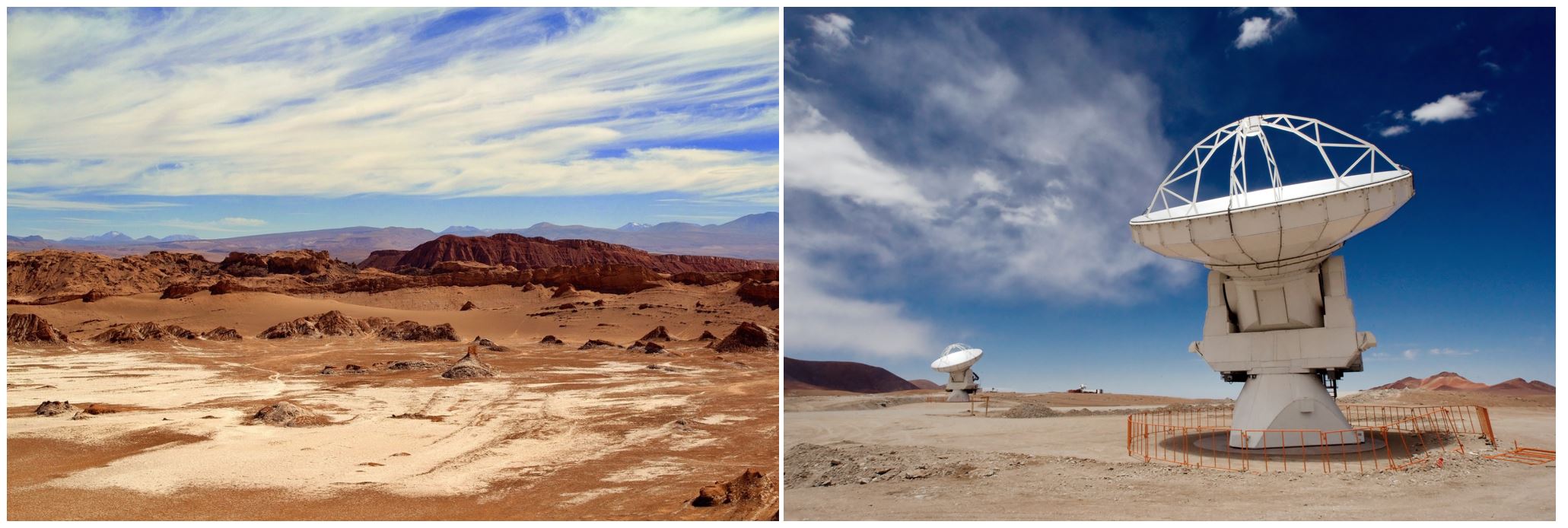
Left: Atacama desert. Right: Two 12-meter antennas of ALMA. CC BY 4.0 by Iztok Bončina/ESO
2 🌞🔭 The Best Place to Monitor the Universe
Atacama Desert, Chile
See the destination
The Desert
The Atacama Desert in northern Chile is considered to be the oldest desert in the world and the driest non-polar desert in the world—that is, a desert outside the polar regions. In some areas, rain has never been recorded. Outside of these extreme areas, sand-colored grasshoppers, beetles, desert wasps, butterflies, and red scorpions can be found as well as a rich variety of flora with over 500 species. The extreme aridity is due to the desert’s location between the Pacific Ocean and the Andes Mountains, which creates a rain shadow effect that prevents moisture from reaching the region.
The Minerals
The desert has rich deposits of minerals such as copper, gold, silver, iron, boron, lithium, sodium nitrate, and potassium salts. It holds the world’s largest natural deposit of sodium nitrate (Chilean saltpeter), which was mined extensively until the early 1940s. Almost all mines were abandoned after the invention of the Haber-Bosch process in the early 20th century.
There are about 170 abandoned nitrate or “saltpeter” mining towns, such as Chacabuco, Humberstone, and Santa Laura Saltpeter Works. Chacabuco became a concentration camp during the Pinochet regime in 1973. It is reported that Chacabuco remains surrounded by approximately 98 landmines left by the Chilean military.
Chile is the second-largest producer of lithium, a critical component of the batteries that power electric vehicles, smart devices, renewable power plants, and other technologies helping the world transition away from fossil fuels. The metal is extracted through the evaporation of brines found beneath salt flats on the Atacama Plateau. Miners pump salty lithium-containing water, called brine, into massive ponds, where it can take years for the evaporation process to separate the lithium. The method is very water-intensive and drains already scarce water resources, damages wetlands, and harms communities [1].
The Astronomical Observations
Due to its high altitude, near absence of cloud cover, dry air, and freedom from light pollution and radio interference from densely populated cities and towns, the desert is one of the best places in the world for astronomical observations.
Chajnantor, one of the driest places on the planet and at 5,000 m above sea level, provides an ideal location for monitoring the universe. In 2013, the European Southern Observatory launched the Atacama Large Millimeter/submillimeter Array (ALMA), a telescope with 66 highly sensitive antennas. One of them is pictured above. This makes it the largest radio telescope in the world. This achievement is the result of a collaboration between Europe (ESO), North America (NRAO), and East Asia (NAOJ), in partnership with Chile.
ALMA hosts guided visits from Monday to Friday for scientific groups, which require arrangements at least one month in advance. So probably for most of us, it is more practical to rely on the live “Virtual Tours” on social media or look at the antennas from a distance.
- Atacama Large Millimeter/submillimeter Array (ALMA), Atacama Desert, Chile
closest town to the observatory is San Pedro de Atacama, which is the leading tourist attraction in Chile. The ALMA Operations Support Facility (OSF or ALMA camp) is located 40 minutes away from San Pedro, at 2,900 m above sea level. - ALMA, ESO website
Reference
[1] Ingrid GARCÉS, Gabriel Alvarez, Water Mining And Extractivism of the Salar de Atacama, Chile, WIT Transactions on Ecology and the Environment 2020, 245(11), 189–199. https://doi.org/10.2495/EID200181
We continue our travel—on to Oceania …
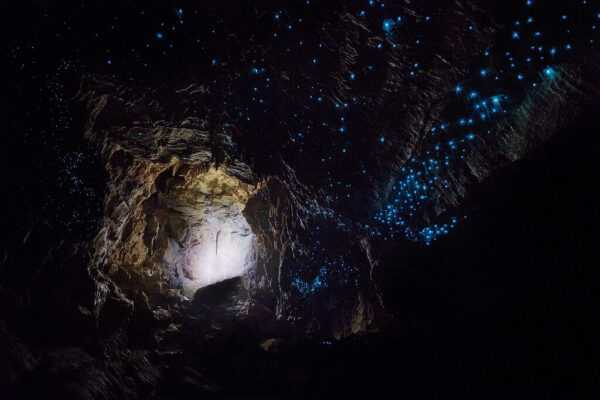
Waitomo Cave CC BY-SA 4.0 by Манько Марко
3 🦠✨ Bioluminescence Illuminating a Cave
Waitomo Cave, New Zealand
See the destination
Beneath the green hills of Waitomo lies a labyrinth of caves and underground rivers. The name comes from Māori, the language of the indigenous Polynesian people of mainland New Zealand: Wai (water) and Tomo (hole) and can be translated as “water that goes through a hole”.
The caves were formed in Oligocene limestone, with most of New Zealand’s limestone deposits originating from this epoch about 23-34 million years ago. These limestones are primarily composed of the mineral calcite (CaCO₃).
The main caves are Waitomo Cave, Ruakuri Cave, and Aranui Cave. Waitomo Cave is famous for its glowworms (Arachnocampa luminosa), which should not be confused with the fireflies. The Arachnocampa luminosa are transparent, worm-shaped fungus larvae that hang from the ceiling. They emit long, sticky threads, hanging down from the walls. The larvae produce bluish bioluminescence glowing from the oxidation of luciferin with the help of the enzyme luciferase (watch the Firefly video to find out how this works). The bluish light attracts insects, which get trapped in the sticky threads. The larvae then retrieve the thread with the prey.
- Waitomo Glowworm Caves, 39 Waitomo Village Road, Waitomo Caves 3977, New Zealand
Also of Interest

The video explains how bioluminescence works in fireflies and why they glow
We are staying in New Zealand …
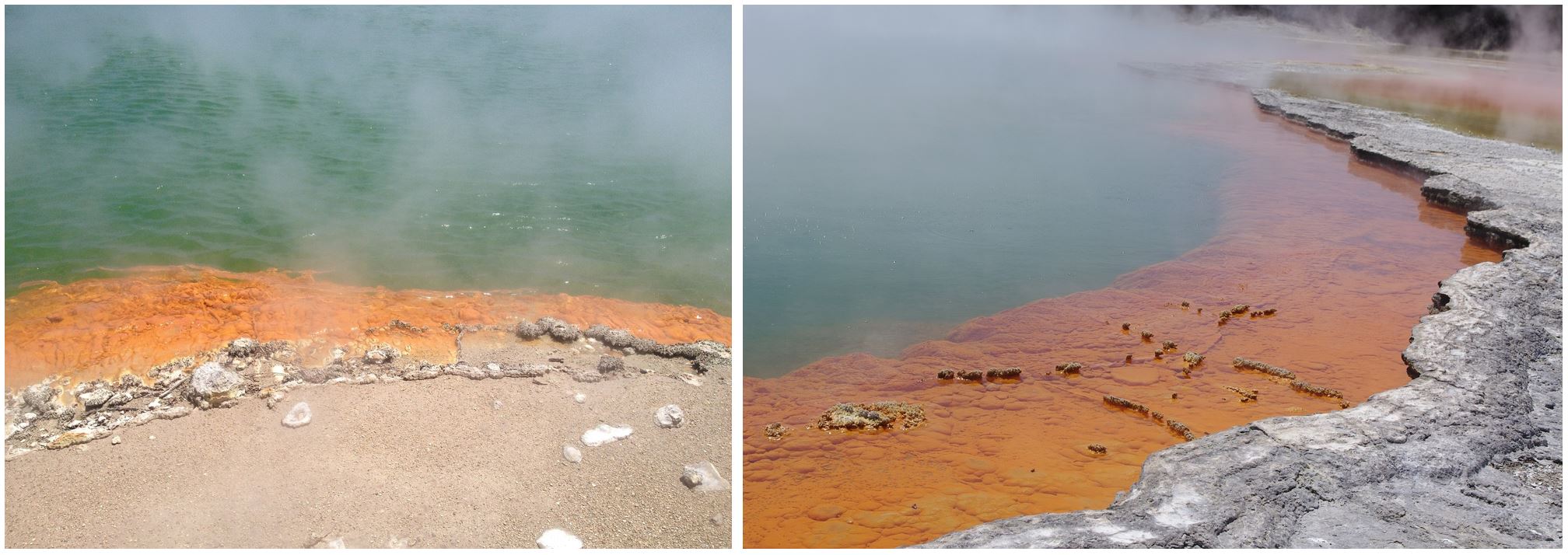
4 🌊🎨 Unnatural Looking Nature
Wai-O-Tapu, New Zealand
See the destination
Wai-O-Tapu Thermal Wonderland is New Zealand’s most colorful and diverse geothermal sightseeing attraction. Covering 18 km², it features one of the country’s largest geothermal systems, shaped by volcanic activity over thousands of years.
Champagne Pool
With a diameter of 65 m, a depth of 62 m, and an estimated water volume of 50,000 m³, the Champagne Pool is one of New Zealand’s largest geothermal sources. Its name comes from the continuous stream of gas bubbles rising to the surface, resembling those in a champagne flute. The escaping gas mixture mainly consists of CO₂, with smaller amounts of N₂, CH₄, H₂, H₂S, and traces of O₂. The 74°C water is oversaturated with the metalloid compounds orpiment (As₂S₃) and stibnite (Sb₂S₃), which precipitate out and form an orange sediment.
The Champagne Pool is also the only known habitat of the bacterium Venenivibrio stagnispumantis, a thermophilic, hydrogen-oxidizing bacterium and the sole member of its genus. This bacterium uses H₂ as an electron donor, O₂ as the electron acceptor, and CO₂ as a carbon source, obtaining energy through the hydrogen-oxygen reaction H₂ + ½ O₂ → H₂O. Elemental sulfur (S₀) or thiosulfate (S₂O₃²⁻) are necessary for its growth [1].
Devil’s Bath
Another pool is the Devil’s Bath, a small, bright green pool. Its color comes from sulfur deposits that rise to the surface and interact with the mineral-rich geothermal waters, with sulfur and iron creating the vivid green hue.
- Waiotapu Thermal Wonderland, 201 Waiotapu Loop Road, Rotorua 3073, New Zealand
Reference
[1] Adrian Hetzer, Hugh W. Morgan, Ian R. McDonald, Christopher J. Daughney, Microbial life in Champagne Pool, a geothermal spring in Waiotapu, New Zealand, Extremophiles 2007, 11(4), 605-614. https://doi.org/10.1007/s00792-007-0073-2
Let’s hop over to Australia …
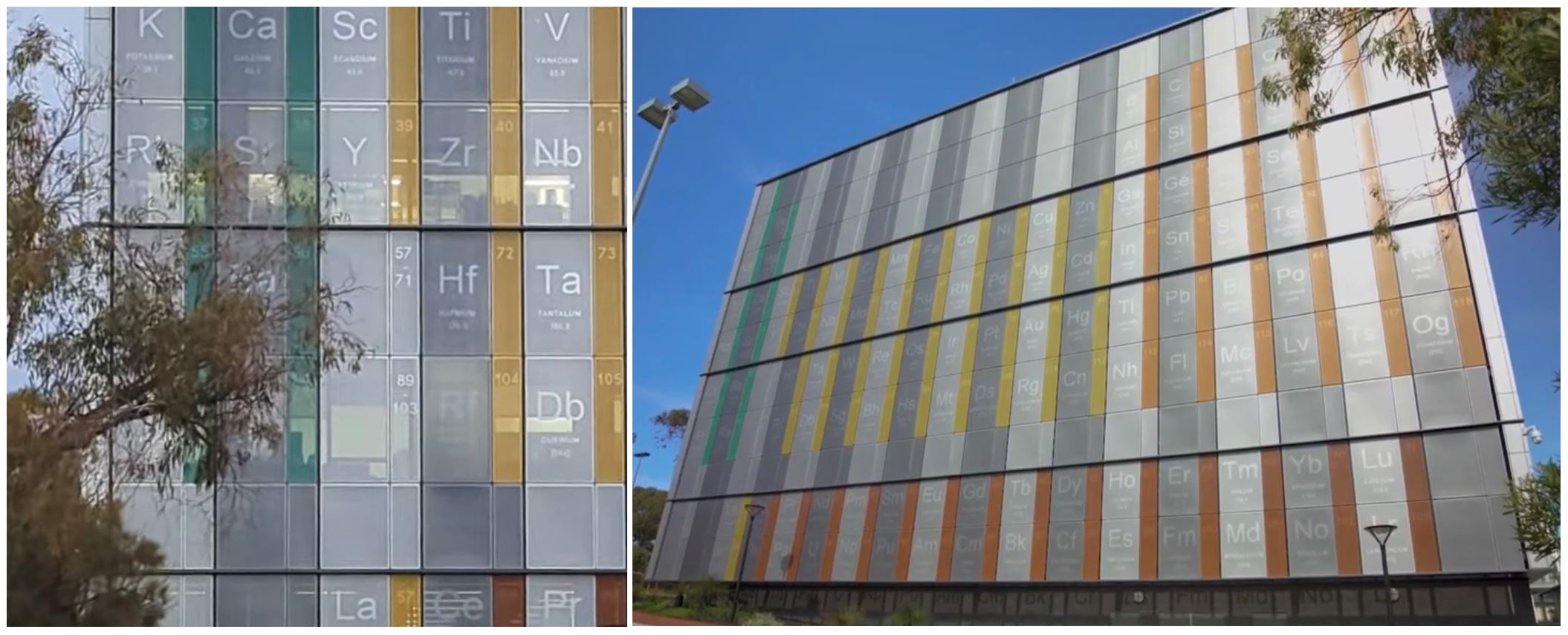
5 🏫📚 Largest Periodic Table
Edith Cowan University (ECU), Joondalup, Australia
See the destination
Edith Cowan University has decorated the exterior wall of its new science building with what it claims to be the world’s largest permanent periodic table of the elements. At 662 m², this table is more than four times the size of the previous record holder, which was created in 2017 at Spain’s University of Murcia and measured 150 m².
The building has five floors, two of which are suer labs where they can do multiple classes simultaneously using state of the art audio visual equipment.
- Edith Cowan University (ECU), Building 15, Joondalup Campus, Joondalup, Australia
We stay in the English-speaking world, but take a big leap into North America …
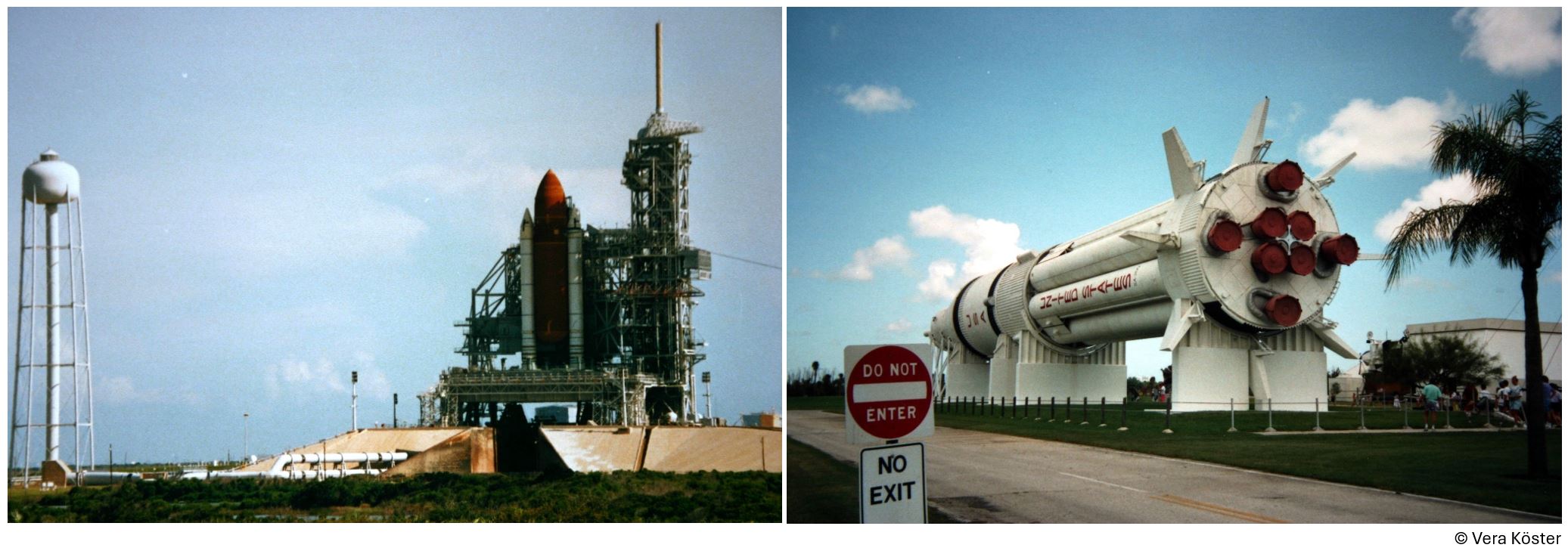
Preparing for a launch and impressions of the Space Center; photos by Vera Köster
6 🚀🧪 The Science Behind Space Travel
Kennedy Space Center, Florida, USA
See the destination
NASA’s Kennedy Space Center is home to one of the world’s largest collections of space exhibits, spacecraft, and memorabilia. The Visitor Center is located near extensive research facilities and NASA’s main launch site (pictured), so if you time it right, you may even be able to witness a live launch.
The center’s many exhibits showcase the technology of current space programs and provide a glimpse of future scientific innovations and advances. Highlights include the Space Shuttle Atlantis and a scale model of the Hubble Space Telescope. The center’s showcases of rocket propellants and the chemistry behind space suits and life support systems offer fascinating insights into the role of chemistry in space exploration.
- Kennedy Space Center, Space Commerce Way, Merritt Island, FL 32953, USA
Continuing our journey in the US …

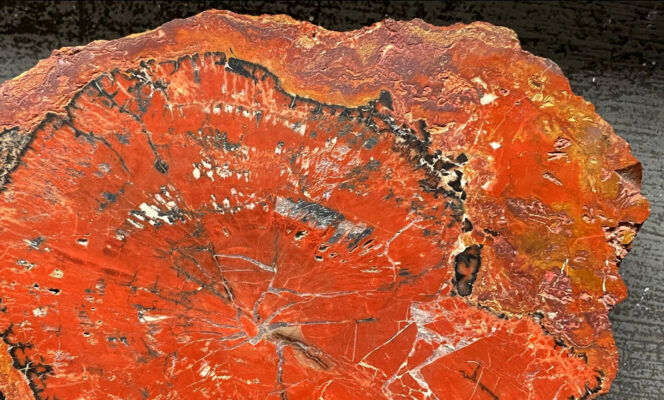
Petrified wood; photo © Vera Köster
7 🌳🦴 Amazing Fossilization
Petrified Forest National Park, Arizona, USA
See the destination
A petrified forest is a fossilized remnant of ancient trees that have turned to stone through a process called permineralization. Over millions of years, minerals like silica, calcite, and pyrite infiltrate the wood’s organic material, gradually replacing it while retaining the original structure. This process involves the deposition of minerals from groundwater, which fills the pores of the wood, leading to a detailed record of prehistoric ecosystems.
Petrified Forest National Park, spanning 81,000 acres, is renowned for its fossils, particularly the fallen trees from the Late Triassic Epoch, about 225 million years ago. These fossilized logs are embedded in the colorful Chinle Formation, which also gives the Painted Desert its name.
- Petrified National Park, located in northeastern Arizona, about 50 miles from the New Mexico border on Interstate 40
Onwards in the USA …
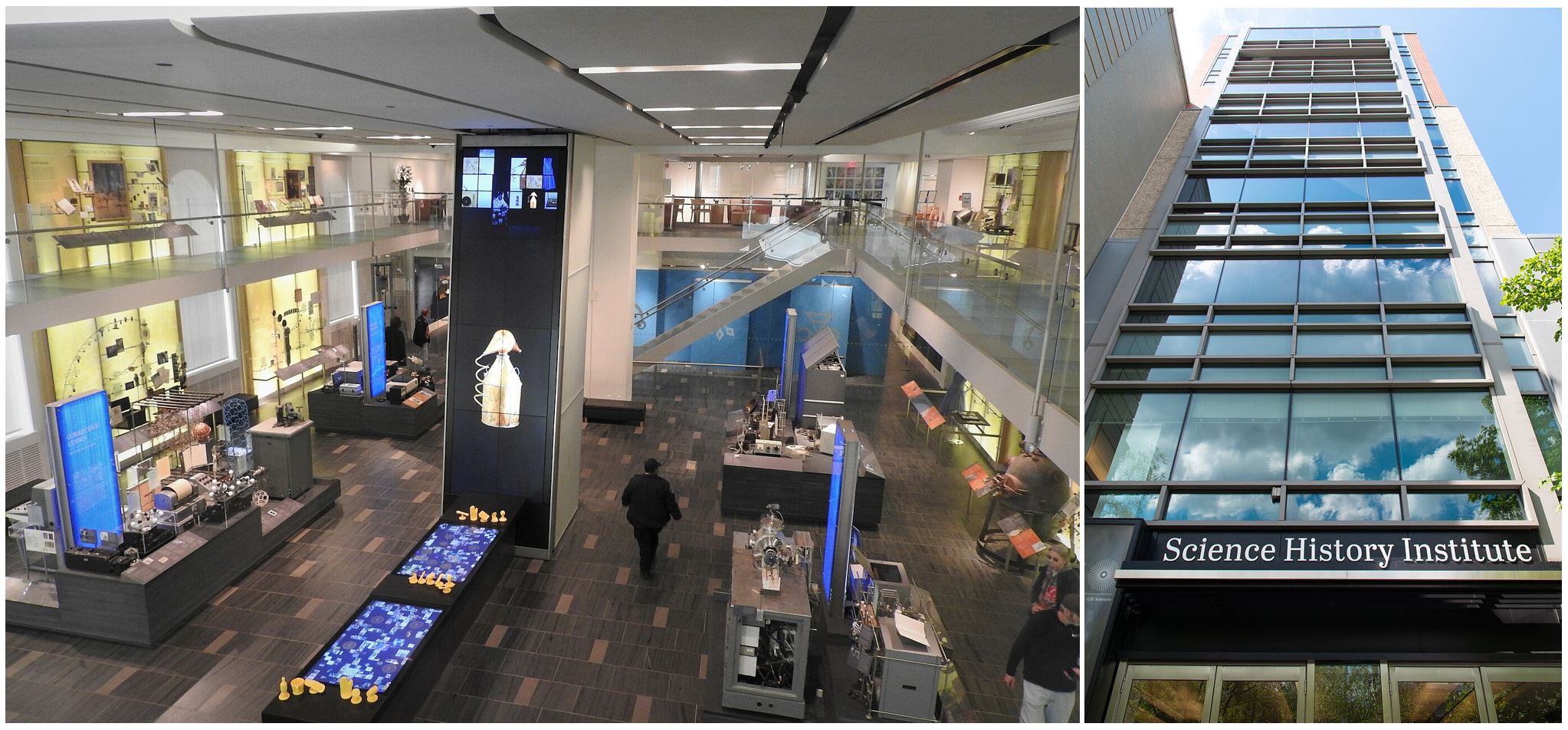
Right: exhibition gallery; photo by Jim.henderson CC BY-SA 4.0. Left: Modern part of the Science History Institute building; photo by Science History Institute/Johanna Austin; CC BY-SA 3.0:
8 ⚗️📜 Journey Through Chemical History
Science History Institute, Philadelphia, PA, USA
See the destination
The Science History Institute is a free museum and library that collects, preserves, interprets, and shares the stories behind science. The nonprofit organization was founded in 1982 as the Center for the History of Chemistry (CHF) by the University of Pennsylvania and the American Chemical Society (ACS). Later, it was joined by the American Institute of Chemical Engineers (AIChE) and the Life Sciences Foundation (LSF), and its name was changed to the current one.
The museum, located in modern facilities behind the original 1865 facade of the First National Bank, features a permanent exhibition documenting 500 years of chemical innovation and temporal exhibitions.
The museum shows original items resulting from chemical discoveries, such as a nylon dress. A centerpiece of the museum, especially for visitors not familiar with sciences, is the Object Explorer. This is a pair of tables with an interactive touch screen. Visitors can place various plastic objects, including a plastic soda bottle, an LED light bulb, and a flip-flop, on the touch screen. An illustrated story about the history and chemistry of the object is then displayed.
The collections include pioneering and landmark instruments, such as early distillation flasks, a 1934 Beckman Model G pH meter, a DuPont 900 differential thermal analyzer, an early custom-built electrospray ionization mass spectrometer used by John B. Fenn, a 1947 Mettler B5 single-pan balance, a 1963 Perkin-Elmer Model 125 infrared grating spectrophotometer, and a c. 1980 automated peptide synthesizer created by Bruce Merrifield. In 2004, the Institute identified a list of “50 Instruments That Changed the World”.
The museum has one of the largest alchemy-related artwork collections in the world, with over 90 historic paintings and 200 works on paper illustrating the work of alchemists and their influence on the development of chemistry as a science.
- Science History Institute, 315 Chestnut St, Philadelphia, PA 19106, USA
The museum is free - Collection: digitized items and contact for search queries
not all items are on display simultaneously
On to the coast …
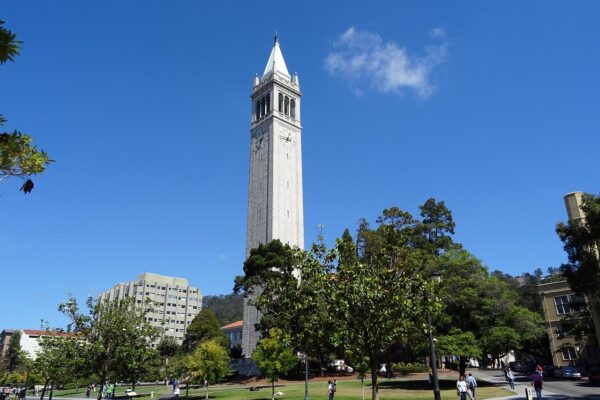
9 🏅🎓 Following in the Footsteps of Nobel Laureates
Berkeley, CA, USA
See the destination
It’s quite fascinating to explore the campus and follow the trails of various Nobel laureates. There are signs everywhere indicating their presence, and on clear days, you can see the Golden Gate Bridge from the campus.
The University of California, Berkeley, also known as Cal or UC Berkeley, was founded in 1868 and named after the Anglo-Irish philosopher George Berkeley. It is a public research university located in Berkeley, California, and is renowned as one of the world’s most prestigious institutions. It has an enrollment of over 45,000 students.
Most of the administrative and academic buildings are concentrated on 72 acres in the western part of the campus. As much of the area is now developed, the construction of new university buildings is extending beyond the campus. To the east of the main campus are numerous research facilities, including the Ernest Orlando Lawrence Berkeley National Laboratory, the Lawrence Hall of Science, and the Mathematical Sciences Research Institute.
Nobel Laureates
Berkeley is home to 110 Nobel Prize winners. Sixteen elements of the periodic table were discovered at Berkeley or by its alumni. Six elements have names associated with the university or researchers who worked there: Californium, Seaborgium, Berkelium, Einsteinium, Fermium, and Lawrencium.
Faculty Nobel Laureates include:
- Chemistry, 2020: Jennifer Doudna shares her Nobel with colleague Emmanuelle Charpentier for the co-development of the genome editing breakthrough CRISPR-Cas9.
- Physics, 2020: Reinhard Genzel won the physics prize for the discovery of, at the center of our galaxy, a black hole four million times the mass of our sun.
- Chemistry, 2014: Eric Betzig’s development of super-resolution fluorescence microscopy allows scientists to look inside cells and visualize the pathways of individual molecules.
- Physiology or Medicine, 2013: Randy Schekman discovered how cells export proteins, allowing the production and secretion of drugs by yeast cells and sparking a biotech revolution.
- Physics, 2011: Saul Perlmutter led a team that discovered the accelerating expansion of the universe; the prize was awarded jointly to Adam Riess — a fellow Cal alum — and Brian Schmidt.
Physics, 2006: Astrophysicist George Smoot shared this prize with Cal alum John Mather for imaging the infant universe. - Chemistry, 1986: Yuan T. Lee designed experiments that sent streams of intensely packed molecules into each other at supersonic speeds, contributing to today’s powerful lasers.
- Physics, 1968: Substituting hydrogen for ether in Donald Glaser’s bubble chamber, Luis Alvarez produced a clearer track of speeding particles.
- Physics, 1964: Charles Townes’s research into the properties of light while designing radar systems during World War II led to the development of the laser.
- Chemistry, 1961: Melvin Calvin revealed the complete path of carbon in photosynthesis to explain how plants convert sunlight to food.
- Physics, 1960: Donald Glaser’s invention of the bubble chamber allowed scientists to track the movement of atomic particles.
- Physics, 1959: Owen Chamberlain and Emilio Segrè discovered the anti-proton, signaling a major leap in the study of matter and antimatter.
- Chemistry, 1951: Edwin McMillan discovered the element neptunium in 1940; he shared his Nobel with Glenn Seaborg.
- Chemistry, 1951: Glenn Seaborg continued Edwin McMillan’s studies on the transuranium elements, and in 1942, he discovered plutonium.
- Chemistry, 1949: By reaching below Absolute Zero for the first time in history, William Giauque’s work proved one of the most basic laws of nature.
- Chemistry, 1946: John Howard Northrop and Wendell Stanley share a chemistry prize; one for isolating a pure enzyme for the first time and the other for isolating a virus, respectively.
- Physics, 1939: Ernest Lawrence, awarded for his work on the cyclotron, was the first Nobelist at a public university.
UC Berkeley College of Chemistry
The UC Berkeley College of Chemistry is one of the fifteen schools and colleges of the University of California, Berkeley. It houses the Department of Chemistry and the Department of Chemical and Biomolecular Engineering. The college occupies a complex of six buildings on the northeast corner of the Berkeley campus which are connected by a network of underground corridors and laboratories.
Completed in 1917, Gilman Hall, where plutonium was identified in 1941, is the oldest of the buildings. Pimentel Hall, one of the largest lecture halls on campus, features a revolving stage for chemistry demonstrations.
Lawrence Hall of Science
The Lawrence Hall of Science, established in 1968 in honor of Ernest Orlando Lawrence (1901–1958), the University of California’s first Nobel laureate, is a public science center dedicated to hands-on science education and offers after school science resources to students of all ages. It features permanent exhibits such as Science on a Sphere (interactive globe displaying real scientific data from Earth including Earth’s weather patterns, ocean temperatures and currents, climate change, day and night views of the Earth, and tsunami and hurricane patterns), an outdoor park about seismological forces that created and still affect the entire San Francisco Bay area, and interactive areas like the Young Explorers Zone and the Animal Discovery Zone. An eight hundred million-to-one scale model of a DNA (deoxyribonucleic acid) molecule is laced on the plaza outside the building.
The center houses a replica of physicist Ernest O. Lawrence’s 1939 Nobel Prize medal, after the original medal made from 23 karat gold and worth approximately $4,000, was stolen and later recovered in 2007.
The center also hosts traveling exhibits and a planetarium, known for its interactive programs.
Sources
- Berkeley’s Nobel laureates; with faculty and alumni laureates in almost all fields
- The Nobel Prize; information on all 16 Nobel Prize winners
- Berkeley College of Chemistry website
- Berkeley Chemistry: 1868 to the Present, Berkeley College of Chemistry website
Onwards to Africa—next, we explore another mining-based destination …
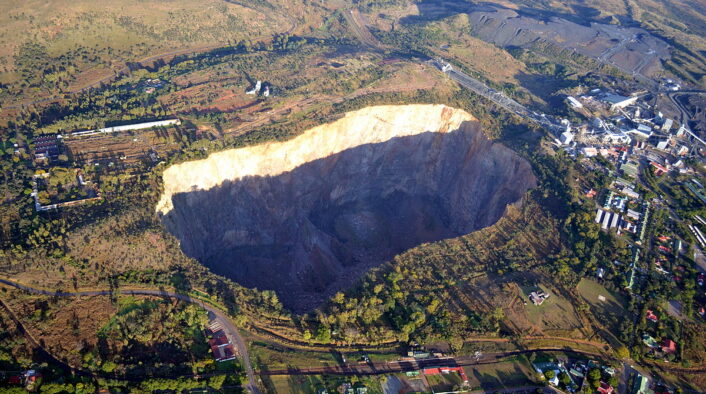
The 190-meter-deep, 32-acre hole in the Premier Mine at Cullinan was an open-pit mine until 1945. Photo by Paul Parsons; CC BY-SA 3.0
10 💎⛏️ Largest Hole and Diamonds
Cullinan Diamond Mine, Pretoria, South Africa
See the destination
Largest Diamond
The Cullinan Diamond, weighing 3,106.75 carats (621.35 g), is the largest rough gem-quality diamond ever discovered. It was founded in 1905 by Frederick Wells, surface manager of the Premier Diamond Mining Company in Cullinan, and named after Sir Thomas Cullinan (1862–1936), the mine’s owner.
The mine is notable for producing over 750 stones exceeding 100 carats, 130 stones over 200 carats, and many over 400 carats, including famous diamonds like the “Premier Rose,” a 353-carat (70.6 g) rough diamond, and the “Golden Jubilee,” a 755-carat (151.0 g) rough diamond. It is also renowned for blue diamonds, contributing to significant finds such as the “Heart of Eternity.” Recent notable diamonds include the “Cullinan Heritage” (507.5 carats) and the “Blue Moon” (29.6 carats).
The Mine
Diamonds form deep within the Earth’s mantle and are brought to the surface through volcanic pipes known as kimberlite pipes. These pipes act as conduits that transport diamonds from their source to the surface, concentrating them in certain areas.
The Cullinan kimberlite pipe, discovered in 1902, began open-pit mining in 1903 and switched to underground mining in 1946. Renamed Cullinan in its centenary to honor its heritage, it has been a prolific source of large diamonds, including those used in the British Crown Jewels. Petra Diamonds acquired a majority stake in 2009 and continues to mine using block cave methods. Block caving is an underground mining method where tunnels are created beneath an ore body, causing the rock to collapse under its own weight for extraction.
Surface tours of the Cullinan Mine provide insights into its rich history and heritage, as well as details on modern mining operations and efficiency improvements.
- Cullinan Diamond Mine, Cullinan (40 km east of Pretoria), Gauteng Province, South Africa
We continue our journey north …
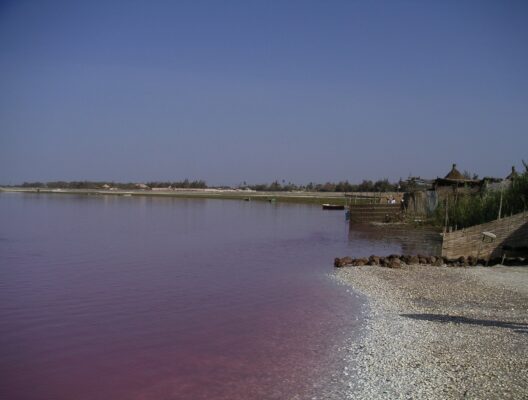
Lake Retba by Arnault CC BY-SA 2.0
11 ☀️🧂 Bright Pink Waters
Lake Retba, Senegal
See this destination
Lake Retba, Lac Rose, or Pink Lake, is a striking and popular destination. Its famous pink hue results from high salt concentrations and the presence of Dunaliella salina, a single-celled algae that thrives in salty environments.
To survive, these organisms have high concentrations of β-carotene to protect against the intense light, and high concentrations of glycerol to protect against osmotic pressure. The orange-red β carotene gives the lake its color. Lake Retba is usually at its pinkest during the dry season (November to June) when sunlight and salt concentrations are at their highest.
There are also halophilic bacteria and archaea such as Halobacterium salinarum in the lake’s salt crusts, which may also be responsible for the lake’s color. These non-algal microorganisms produce a carotenoid pigment in their cell membranes, which is either the main cause or a contributing factor to the overall coloration of the lake.
With salt levels similar to those of the Dead Sea, Lake Retba is economically significant. Local harvesters collect thousands of tons of salt each year for cooking, food preservation, and export to neighboring countries. Visitors can float on the lake due to its high salt content, similar to the Dead Sea experience.
Lake Retba is the only pink lake in Africa, though similar phenomena occur elsewhere, such as Torrevieja Lagoon in Spain and Lonar Lake in India. Both take on rosy hues from the same single-celled algae. The lake was also a finish point for the Dakar Rally before it moved to South America. The Dakar Rally, a prestigious and demanding off-road race that originally ran from Paris to Dakar, has been held outside Africa since 2009 due to safety concerns, first in South America and, since 2021, in Saudi Arabia, and remains a major international motorsport event.
- Lake Retba, Cap Vert Peninsula, Senegal
30 km from Dakar, Senegal’s capital
There are other pink lakes around the world, including Lake Hillier, Hutt Lagoon, Lake Eyre, and Quairading Pink Lake in Australia, Las Salinas de Torrevieja in Torrevieja, Spain, Dusty Rose Lake in Cariboo J, British Columbia, Canada, Masazir Lake in Masazır Gölü, Azerbaijan, Laguna Colorada in Bolivia, and the Great Salt Lake in Utah, USA [1].
Reference
[1] Kyle Kroeger, 12 Best Pink Lakes in the World to Visit, Via Travelers February 15, 2024. (accessed July 2, 2024)
We remain in Africa …
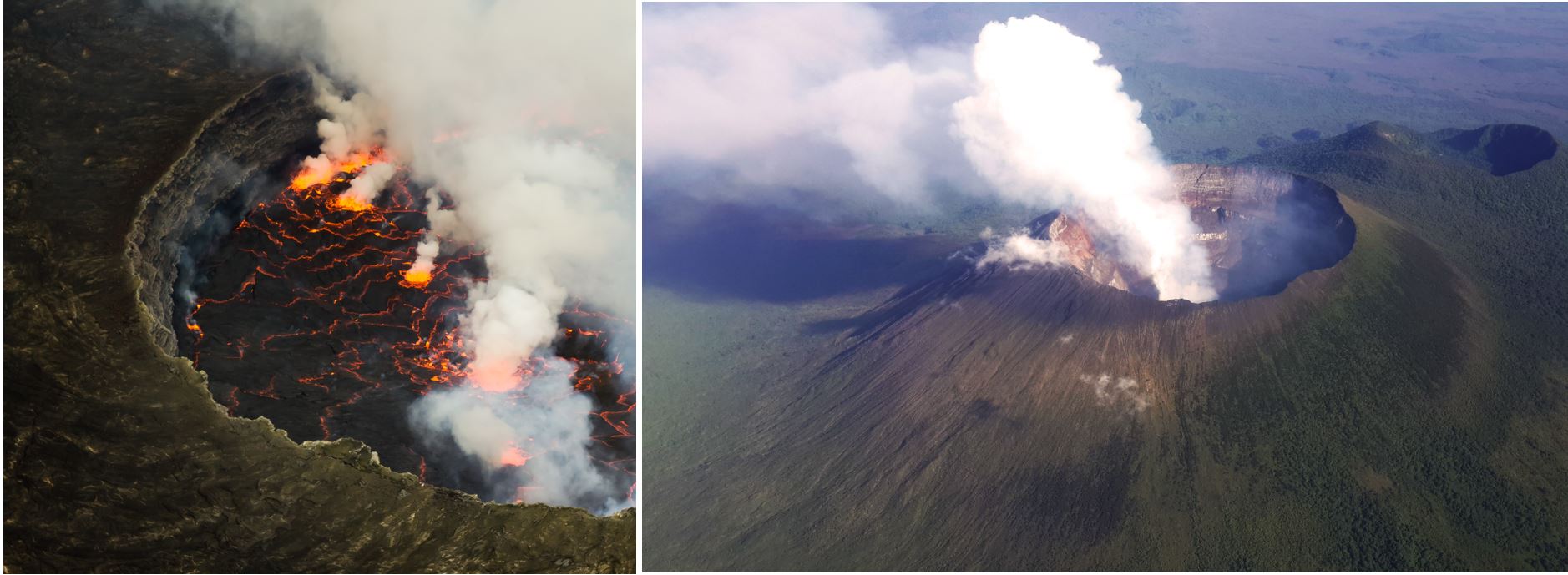
Left: Cai Tjeenk Willink CC BY-SA 3.0 Right: MONUSCO / Neil Wetmore CC BY-SA 2.0
12 🌋🪨 One of the Most Active Volcanoes
Nyiragongo, Democratic Republic of Congo
See the destination
Nyiragongo is a 3,470-meter stratovolcano in the Democratic Republic of Congo, one of the world’s most active volcanoes. Located about 20 km north of Goma, it is part of the Virunga Volcanic Province along the East African Rift System. The volcano partly overlaps with two older volcanoes, Baruta and Shaheru, and is also surrounded by hundreds of small volcanic cinder cones from flank eruptions.
Nyiragongo features a 1.2-km-wide summit crater with a persistent lava lake, active since at least 1971. The volcano’s lava lake is one of the largest known lava lake in recent history, providing a unique opportunity to study volcanic processes and magma chemistry. Its eruptions have been primarily confined to the summit crater, with some flank lava flows. The volcano’s cone is made up of pyroclastics and lava flows, and its lavas are low-silica, alkali-rich, ultramafic rocks. These include melilitites, leucites, and nephelinites, resulting in extremely fluid lava flows that can travel at speeds up to 100 km/h (60 mph), making them particularly hazardous.
Volcano Trek
The Nyiragongo Volcano Trek begins at the Kibati Ranger Post at 1,870 meters. It typically takes 4 to 6 hours to climb and about 4 hours to descend, depending on the group’s pace.
The trek starts through dense forest where wildlife such as monkeys and bushbuck may be spotted. It then moves through open trails with valley views, old lava flows with steaming fissures, and high montane forest. The final section is a steep 300-meter climb to the summit.
At the top, hikers are rewarded with views of the large lava lake and a breathtaking nighttime spectacle as Nyiragongo’s lava lake glows against the starry sky.
An awe-inspiring natural wonder, but one that poses considerable challenges and potential dangers.
- Mount Nyiragongo, Virunga National Park, Democratic Republic of Congo
20 km north of Goma
And now, let’s continue our journey to Asia.

Photo: YSoHome Jacaranda Lilau, wikimedia commons, Creative Commons Attribution-Share Alike 4.0 International
13 🏛️🧪 Celebrating Science
Shanghai Science and Technology Museum, China
See the destination
The museum is huge, with 13 permanent exhibitions, including World of Robots, Cradle of Design (where visitors can use Computer-aided design (CAD)/Computer-aided manufacturing (CAM) to design and build small things), Children’s Rainbow Land, Light of Exploration (highlighting human scientific achievements of the 20th century), Human and Health, Space Navigation, World of Animals, Spiders Exhibition. The Chinese Ancient Science and Technology Gallery showcases ancient Chinese inventions and achievements. The Explorers’ Gallery highlights both Chinese and foreign explorers. The Academicians’ Gallery showcases contemporary scientists from China, especially those from Shanghai.
Although the museum aims to represent cutting-edge scientific developments with innovative exhibition methods, some exhibits have not been updated since their installation. Opened in 2001 and completed in 2010, the museum also features four large science theaters, including two IMAX cinemas. There are also changing exhibitions showcasing everything from pottery to photography, as well as activities such as science shows and training camps.
- Shanghai Science and Technology Museum, 2000 Century Avenue, Pudong, Shanghai, China
Continuing in India …
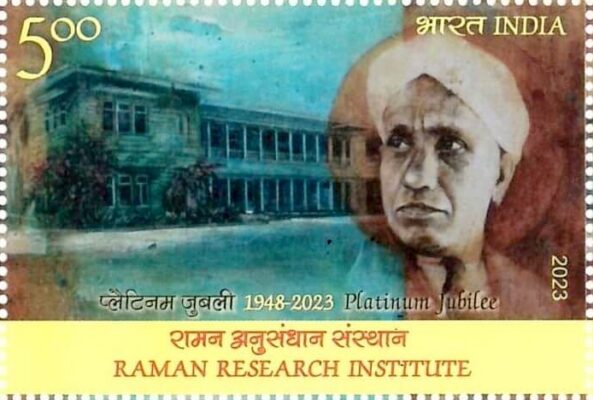
14 🏛️👨🔬 Collection of Nobel Laureate C. V. Raman
Rai Bahadur Bissessurlal Motilal Halwasiya Science Museum, Bengaluru, India
See the destination
Indian physicist Sir Chandrasekhara Venkata Raman (1888–1970) won the 1930 Nobel Prize in Physics “for his work on the scattering of light and for the discovery of the effect named after him.” In a quiet corner of the Raman Research Institute’s main building is the ‘Rai Bahadur Bissessurlal Motilal Halwasiya Science Museum,’ offering a unique glimpse into Sir C. V. Raman’s personal collection.
Raman became the first Indian director of the Indian Institute of Science (IISc) in Bangalore in 1933, retiring in 1948 to establish the Raman Research Institute a year later. He served as its director and remained active there until his death in 1970. The museum’s collection, which Raman began assembling in 1948, reflects his curiosity about natural colors and the effects of light on various materials. His collection includes iridescent substances such as rocks, gems, minerals, and butterflies, housed in a five-room gallery that Raman used himself. The final room of the gallery was used by Raman to study the effect of UV light on amethyst and rubies.
Raman took great pride in showing his collections to visitors. Many international scientists visited the institute, including J. D. Bernal, E. C. Bullard, Patrick Blackett, Charles Galton Darwin, Paul Dirac, G. Gamow, J. B. S. Haldane, Linus Pauling, C. F. Powell, L. Rosenfeld, G. Wentzel, and Norbert Wiener.
The museum is privately run by P. S. Sasikumar, who has managed it for over 40 years. As a one-man operation, entry depends on Sasikumar’s availability, and visits are arranged at the institute’s discretion.
- Rai Bahadur Bissessurlal Motilal Halwasiya Science Museum, Raman Research Institute, Bengaluru, India
Sources
- Joseph Krupa, Museum highlights city’s Nobel Prize, Deccan Herald November 8, 2019. (accessed July 30, 2024)
- National Science Day 2023 Celebrations at RRI highlighted by various newspapers, Raman Research Insitute March 3, 2023. (accessed July 30, 2024)
On to southeastern China …
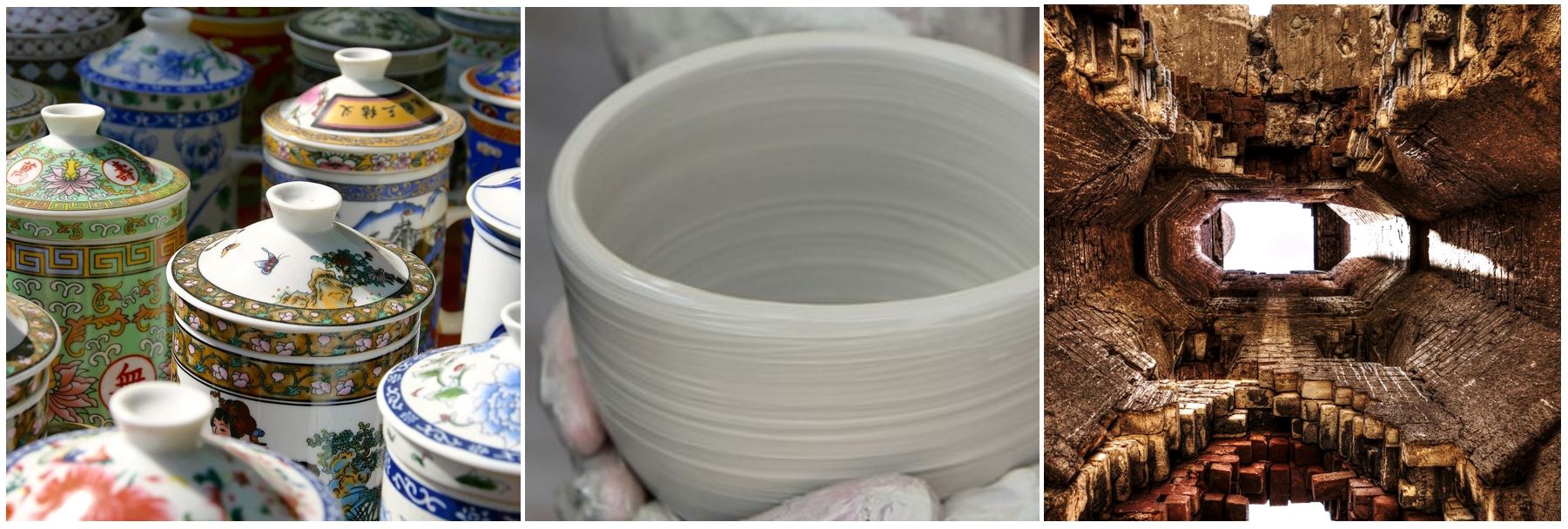
15 🏺🔥 Porcelain Capital
Jingdezhen Ancient Kiln & Folk Customs Museum, Jingdezhen, Jiangxi Province, China
See the destination
Jingdezhen is known as the “Porcelain Capital” due to its production of Chinese ceramics for over 1,000 years, during which it was recognized for its high-quality porcelain. By the 14th century, Jingdezhen had become the largest center for porcelain production, a status it maintained for centuries. From the Ming period onwards, its official kilns, controlled by the emperor, produced “imperial porcelain” in large quantities for the court and as gifts, with a significant amount exported to Europe.
The Great Ming Dynasty, which ruled China from 1368 to 1644, was the last dynasty led by the Han people. It was succeeded by the Great Qing Dynasty, a Manchu-led regime that ruled from 1644 to 1912 until its overthrow in the Xinhai Revolution.
Jingdezhen’s location is advantageous due to its proximity to high-quality petuntse deposits and surrounding pine forests, which provided the necessary wood for kiln firing. Its position by the river also facilitated the transport of fragile porcelain.
Ancient Kiln & Folk Customs Museum
In the exhibition area, visitors can enjoy an exhibition on ceramic traditions and musical performances with ceramic instruments amidst the historical architecture of twelve buildings.
The expansive, beautifully landscaped site known as Gǔ Yáo (古窑, Ancient Kiln) features traditional porcelain-making equipment and restored ancient kilns, with staff demonstrating their historical use. While some buildings date back to the Qing and Ming periods, most have been rebuilt.
The exhibition area shows ancient kilns, including the Qing Dynasty’s Jingdezhen kiln, the Ming Dynasty’s Gourd kiln, the Yuan Dynasty’s Steamed Bun kiln, and the Song Dynasty’s Dragon Kiln. Visitors can explore historical porcelain crafting processes and view traditional porcelain treasures.
Additionally, the museum includes displays on ceramic traditions and musical performances with ceramic instruments, all set amidst the historical architecture of twelve buildings.
Imperial Kiln Museum (Imperial Kiln Relic Park)
Located in the heart of the historic district, the museum features more than half a dozen brick vaults based on traditional kiln designs, each varying in size, curvature, and length. These vaults have been carefully integrated into the existing ruins of old kilns.
Historically, craftsmen built unique kilns without scaffolding, using thin, lightweight bricks to maximize the interior space with a minimum of material. When designing the museum, recycled kiln bricks were mixed with new bricks. Recycling kiln bricks for new construction is an important tradition in Jingdezhen, as the kilns need to be dismantled regularly to maintain their efficiency.
Exhibits include kiln displays, ancient porcelain pieces, and stories of past workers. The museum also has a bookstore, cafe and tea room. The museum was completed in 2020.
Porcelain
Porcelain, also known as china or white gold, is a fine ceramic product. It has a white, dense, and non-porous body that is translucent in thin layers. Porcelain is made from a blend of:
- Kaolin: A special, iron-poor clay primarily composed of kaolinite, named after the Chinese mountain Gaoling (高岭)
- Petuntse: A feldspar or mica rock
- Quartz
which transform into a glass phase and mullite during the firing process. Depending on the firing temperature and the addition of volume proportions of kaolin, feldspar, quartz, and additives such as bone ash, different types of porcelain are obtained.
The distinguishing feature of porcelain compared to other ceramics is not its high firing temperature but its sintering behavior: The feldspar in porcelain melts during firing but does not recrystallize upon cooling due to its toughness. Thus, porcelain contains a supercooled melt, similar to glass.
In contrast, other ceramics like stoneware or earthenware form purely crystalline sintered structures. This unique characteristic can give some porcelains, especially those with thin walls, a certain translucency.
Glazed or unglazed, porcelain is used for making household items, technical products, and artistic objects. Porcelain has a dense body, a shell-like fracture, and high hardness. It is resistant to acids and alkalis, though it can be attacked by hydrofluoric acid. It produces a bright sound, is an excellent electrical insulator, and is a poor heat conductor. Additionally, its low abrasiveness makes it ideal for applications such as the manufacture of mortars.
- Jingdezhen Ancient Kilns and Folk Custom Museum, No 1, Guyao Road, Cidu Avenue, Jingdezhen, Jiangxi Province, China
- Imperial Kiln Museum, 187 Zhushan Middle Road, Zhushan District, Jingdezhen City, Jiangxi Province, China
And finally continuing in Japan …
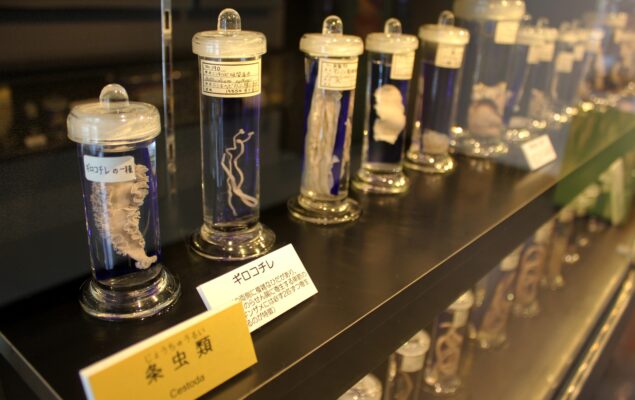
Exhibits of the Meguro Parasitological Museum; photo by Laika ac from USA; CC BY-SA 2.0
16 🪱🦠 Discover Nature’s Beauty And Repulsion
Meguro Parasitological Museum, Tokyo, Japan
See the destination
Admittedly, it’s a bit more biology than chemistry. The small museum was founded in 1953 by Dr. Satoru Kamegai, a medical doctor, to raise public awareness of parasitic diseases.
It displays various parasites and their effects on two floors: the first mainly with explanations about parasites in the natural world and their life cycles, and the second with many exhibits of parasites, infected animals and humans, including a super giant tapeworm. The explanations are in Japanese, but the museum offers free Wi-Fi and multilingual text guides via QR codes, providing information in English and other languages. The research library contains 60,000 parasite specimens, as well as 50,000 papers and 5,000 books on parasitology.
It’s certainly not for everyone; the website says it attracts science enthusiasts, the morbidly curious, and first-date couples.
- Meguro Parasitological Museum, 4-chōme-1 Shimomeguro, Meguro City, Tokyo 153-0064, Japan
The museum is free to the public and relies on donations. It is privately owned and receives no government funding.
😊 We hope you enjoyed our chemistry world tour as much as we did.
Maybe you have already visited one or more of these places or other destinations you would recommend. Feel free to let us know in the comments below.
Acknowledgment
A big thank you to Daniel Rabinovich, USA, and Katrin and Thorsten, Germany,■ for their great ideas and suggestions for travel tips.
Also of Interest

Every day until December 24 we will unlock a new destination for your bucket list—join our chemistry Europe trip
Video: How Do Oxygen Masks on Airplanes Work?
The short video explains where the oxygen comes from and how it is released
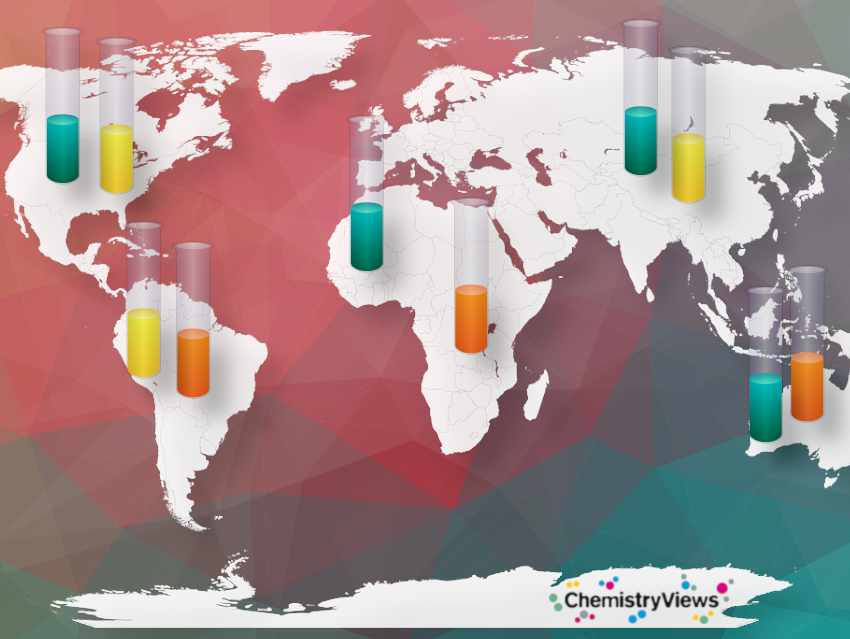






Hallo
Greetings from Brasil
I would add: the three great mineralogy collections (École des mines, Galerie de Minéralogie et de Géologie of the Muséum national d’histoire naturelle and the collection des Minéraux of Sorbonne Université on the Pierre and Marie Curie campus) and the Museum of Arts and Crafts in Paris, the Deutsche Museum in Munich, the Liebig School Laboratory Museum in Giessen, the Nobel Museum and the small museum housing the Berzelius Collection in the old astronomical observatory in Stockholm, the Science Museum in London, the Cavendish Museum in Cambridge, and the CosmoCaixa Museum Of Science in Barcelona, at least.
You friends of the European Chemical Society, taking advantage of this initiative, would be the most appropriate to edit a book similar to the marvelous “The Physical Tourist: A Science Guide for the Traveler”, which also is precious for us, chemists.
Hello
Thank you very much for your feedback and ideas. We have already included some of them, along with others from Europe (24 Must-See Destinations in Europe), but we are always happy to receive more travel tips for Europe and beyond!
The Cavendish Museum in Cambridge, UK, and the CosmoCaixa Museum of Science in Barcelona, Spain, are great additions to the list.